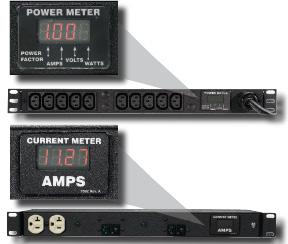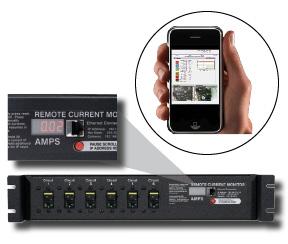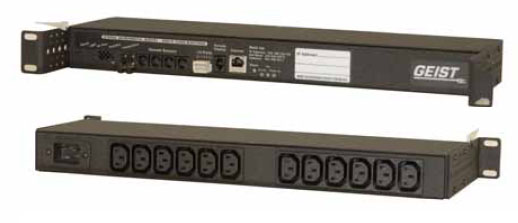BASIC & METERED PDU, MONITORED PDU, SWITCHED PDU, SATELLITE PDU, AUTOMATIC TRANSFER SWITCH PDU, VARIABLE SPEED FAN CONTROLLER, ENVIRONMENTAL MONITORING UNIT.
Power Distribution Unit (PDU) and Environmental Monitoring (ENV) Product Overview.
Basic PDUs are available in a wide variety of power capacities and many different physical shapes and sizes. They all serve the same basic function of distributing power from a single input point to multiple sockets.

The safe and efficient delivery of power to IT equipment is an obvious need especially when the IT function is critical to the operation an organisation. The ongoing increase in power consumption in server racks, data closets, network rooms and data centres means that more and more power capacity, more power outlets and consequently more PDUs are required. Since the circuits supplying the power to the IT equipment are of limited capacity it is very important to be able to see whether a circuit has any capacity left before adding new equipment. Overloaded circuits can cause fuses to blow, breakers to trip and a complete loss of IT capability. Metered PDUs contain a local LED Amp Meter or Power Meter which gives immediate information as to the power load on the circuit. This information allows you to judge where best to locate and plug any new IT equipment without disturbing servers or processes which are already running. Power Meters give fine detail of what is happening on any circuit by providing information including real-time voltage, wattage and power factor.

Monitored PDUs go one or two steps further than metered PDUs; Current monitored PDUs offer real time and historic data on power usage on a manager’s desktop allowing him to see at a glance exactly what current is being drawn from any PDU in the Datacenter at any time – he has the same information as if he were walking around the Datacenter looking at each PDU individually. Power monitored PDUs work in exactly the same way as Current monitored PDUs but as well as information on current (amps) drawn a view is given of overall power usage – volts, real power, apparent power, power factor and kWatt-hours. As well as providing information on power usage in real time at the rack (very useful for on-site staff working at the coalface), they offer the same information on the desktop of a Datacenter Manager, Facilities Manager etc. Beyond that, Monitored PDUs offer stored and graphed data on power usage, so that it’s possible to observe power usage history and trends, and see for example how close to capacity some circuits are at peak usage times. From this information, it’s possible to reconfigure circuits and rewire to achieve the safest and most balanced loads across all available circuits. Metered PDUs are a very useful tool when moving, adding or changing IT equipment, since the resulting changes in power use are immediately apparent. No software is necessary to use monitored PDUs – they are accessible by IP address just like any other network device. Upper and lower power thresholds can be set, and alarms generated when these limits are approached, reached or breached. Alarms can be generated by email, SNMP trap, XML or local (buzzer) alarm. Some monitored PDUs allow additional functionality, such as the monitoring and reporting of temperature, humidity, airflow, light and sound levels etc. as well as monitoring of electrical power. When multiple metered PDUs are deployed, it’s possible to have their results and reports displayed in individual windows, but optionally Geist’s Console Management or Environet Software can be used to bring the reports of many units onto one graph or table, so that a view of the IT environment as a whole can be viewed. Monitored PDUs usually monitor the whole circuit (or each phase of it’s a three phase PDU) but can monitor power usage at individual socket level if required.


Switched PDUs provide generally the same minute by minute, day by day information on power (and environmental) conditions as metered PDUs but additionally allow a manager to elect to power any socket ON or OFF either immediately on command, or by a pre-programmed schedule – again this can be done over IP. While Monitored PDUs can provide comprehensive power and environmental information remotely, only a Switched PDU can allow a Data Center Manager to react immediately to alarms by resetting sockets immediately to ON or OFF so as to power down critical equipment in a controlled way, or to power down non-critical equipment allowing critical servers to remain up during low power availability periods. A Server cabinet is usually closed, for security and safety reasons, and as such contains its own microclimate. Geist’s Intelligent (Metered, Monitored and Switched) PDUs can be programmed to react to changing conditions within that microclimate, for instance in an overheating situation, more fans can be automatically brought into action, or non-critical machines can be closed down.
Geist’s PDU range is completely interoperable with other Geist products such as the Automatic Fan Speed Controller, or Environmental Monitoring products.
Geist’s Power Monitored and Switched PDUs can have additional RJ ports which allow communication with either Sensors (Environmental monitoring sensors, door open, water presence etc.) or with “Satellite” PDUs. Connecting a Satellite PDU to a Current Monitored or Switched PDU allows multiple PDUs to be monitored and graphed from one IP address, and means that information is immediately available in a clear graphic format which allows visibility of the actual and relative capacities of all PDUs on one graph – absolutely the best way to see how well power Distribution is balanced across a row of racks or a whole Network room or Datacenter.
SATELLITE SWITCHED PDUs are a way to add some switching capability (the ability to turn equipment ON or OFF remotely so that temperamental, critical or part-time usage devices can be controlled remotely, cold-booted etc, without the investment or perceived “risk” (see “to switch or not to switch?”) of having all sockets switchable.
ENVIRONMENTAL MONITORING UNITS

Many of the PDUs above contain environmental monitoring – the ability to interrogate sensors and report back on temperature, humidity, airflow, light sound etc. –every aspect of the microclimate in any rack or Datacenter. Geist also offers a range of stand-alone environmental monitoring units.

Geist’s range of Environmental Monitoring units include self contained mini units which can be powered by POE (Power over Ethernet) up through 1U Monitoring Units which can support up to 60 sensors. Sensors can also include Satellite PDUs and Satellite Switched units, so it is quite possible to mix and match Geist PDU and Environmental products to achieve a bespoke solution fore any application.
The final step in Geist’s Environmental monitoring offering is a unit with relays which can automatically respond to alarms, by (for instance) switching on or off more fans, activating or de-activating Air Conditioning units or ventilation units, opening doors, triggering audible or visible alarms etc. This means that either the whole microclimate within the rack can be automatically controlled, or that some initial actions can be sanctioned by a Geist unit whilst waiting for human help to arrive.
This takes us neatly to Geist’s

The cooling Datacenters can account for anything up to 40% of the total energy bill. Air conditioning is normally set to “overcool” (better safe than sorry?) Datacenter temperature is raised massively by the hot air exhausted from Server racks – thus obviously the need for cooling. By fitting a Variable Speed Fan Controller into a rack the temperature inside the rack can be controlled so that the temperature is kept close to the optimum requirement of the servers, but not unnecessarily cool. The VSFC recirculates no more air than is actually needed by the servers to maintain their required operating environment and so much less hot air is expelled to impose cooling load on the Air conditioning units. The offers savings both by reduced usage of rack based fans and more importantly, lowers the ambient temperature of the Datacenter so saving considerable energy on cooling. Reduced fan noise in the Datacenter is a welcome and useful bonus.
